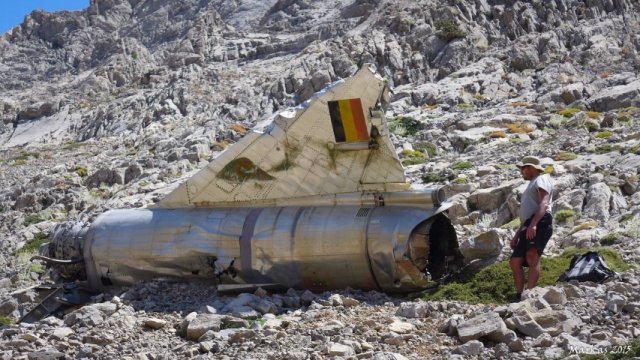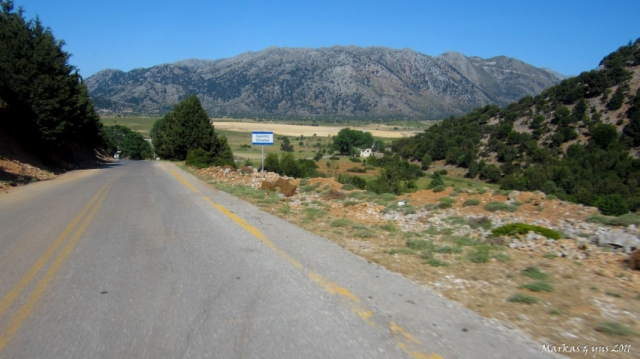Press here.
Places near Petachteni Samarias
Samaria or the Samaria Gorge is one of the main sights of Crete. Every tourist who visits Crete will have heard of this beautiful gorge or soon will.
Samaria Gorge is found in the White Mountains of south-west Crete in the district of Chania. They are called the White Mountains because the sun shining on the limestone rock of their peaks make them appear that colour.The capital of the district of Chania is the town of that name. It`s a very popular tourist destination on the north coast of the island. If you look at a map of Crete you will find the Samaria gorge directly south of the town but on the opposite coast.The White Mountains contain over forty gorges of various sizes. The best known are Imbros Gorge, The Gorge of Agia Irini and the Samaria Gorge which is definitely the most famous of them all. Even though these gorges are all to be found on the same part of the island of Crete, they all have different characteristics.Samaria Gorge is named after a village of that name which is found about halfway down the gorge. The village in turn gets its name from a small 14th century church sited close by. This is the church of the Holy Mary, in the Greek language, "Osia Maria." So it is easy to see where the name Samaria comes from!The village has been deserted since 1962. The last inhabitants had to leave when the whole area was designated as a National Park. Although many of the old houses still remain, they only act as accommodation for the Park wardens. The old church of Osia Maria is still there, a little way out of the village.All the gorges in the Crete Mountains in Chania were formed by the same geological process. Water ate away the soft limestone rocks over thousands of years after the land had been uplifted by seismic activity. This water erosion has also led to huge numbers of caves being formed. There are as many as 3,000 over the island. A lot of these caves are archaeologically and religiously significant. Over a 100 of the caves have churches in them.The Samaria Gorge starts near the small town of Xyloskalo on a level area in the White Mountains called the Omalos Plateau. The name Xyloskalo can be translated as "wooden stairway." This is because the locals had built just that thing to help them enter down the steep opening into the gorge.The Omalos Plateau is over 1,200 feet above sea level and the gorge runs in a southerly direction from there down to the south coast of Crete near the village of Agia Roumeli.Of all the things to do in Crete visiting the Gorge of Samaria is a must for many tourists, especially those on Crete walking holidays. Mnay Crete excursions are based around this great hike.Coaches will collect you early in the morning and take you to your starting point at Xyloskalo in the Crete mountains. Once you have completed the hike and reached Agia Roumeli on the coast, you catch a ferry boat to the nearby port of Hora Sfakion where your coach will collect you once more.The locals call the gorge "Farangas" which means "great gorge." They also like to claim that it is the longest gorge in Europe, but that is debatable.What is certain is that in some places it can definitely be counted amongst the narrowest!The most dramitic part is a a place known as "Sideroportes" or the "Iron Gates." Here the Samaria gorge is so narrow, being about four metres wide, that you feel as though you can reach out and touch both walls at the same time.If you look up at the cliffs, which rise almost vertically above you for 350 metres, you feel totally overawed!The journey down the gorge, from Xyloskalo to Agia Roumeli on the coast, is about 18 kilometres and although the hike is not an easy one, it is extremly beautiful. The path follows a clear stream which goes through heavily scented pine forests of tall Cypress trees. There are many olive trees and some small fields with low stone walls.The Samaria Gorge is only open to visitors between the beginning of May and the middle of October. There a charge for entering the gorge, at the moment it is 5 Euros. This goes towards the maintenance of the National Park. You must keep your ticket and hand it to the warden as you leave the park, this ensures that no-one is left in the gorge overnight.During the winter months you are unable to go down the gorge.This ban can even occur in the summer season if there has been rain. This is because the pretty stream you cross many times on your hike down the gorge can turn into a raging torrent. Rain or melting snow in the Crete mountains can raise the height of the water considerably.In fact the Village of Agia Roumeli, at the bottom of the gorge, was badly flooded in the 1950`s. There are still some ruined houses which are only now being rebuilt.High winds can also cause problems. Although you may not be aware of them when you are down in the gorge they have been known to cause stones to fall from the 350 metre high cliffs. In fact there are signs warning of this danger.Any walk down the gorge usually becomes a competition to spot the rare Kri-Kri.This is a Cretan Wild Ibex with distinctive curved horns. It was introduced into Samaria gorge as a refuge for it. In fact this is only one of two places it is to be found.If you are very lucky you may spot some rare birds such as the Griffon Vulture, Bonelli`s Eagle and the Golden Eagle.One thing about Samaria Gorge you should be aware of is its popularity. During the tourist season there will be lots of people hiking through it every day.The beauty and dramatic quality of Samaria Gorge make it one of the most popular gorges to visit in the world.
In the picturesque village of Zourva by an region with genuine Cretan hospitality and beautiful walks, the visitor can experience intense emotions. Opposite the village hidden within the cliffs and pines is located the water source and the gorge of Tromarissa that starts from there.
The track we follow starts at an altitude of 600m in the village of Zourva, and leads, by a regular but easy ascent through a pine trees forest, to a waterfall situated at 1000m high in the mountain landscape. Soon you are dominated by the view of the Madares, the White Mountains. The name of the gorge and region is linked to popular myths about fairies and elves , as well as significant moments of our modern Cretan history .
Access to the canyon by about two hours walking througt a well signed path Zourva Village - Tromarissa, which belongs to the network of Green trails, which recently (2008) completed the Mountaineering Club of Chania.
This is a technical canyon and the descent requires knowledge with rope. It has 20 technical descents with the highest at 30 meters height, and other smaller which does not require ropes, but rock rappelling. The Tromarissa essentially is a stream and has water only after a downpour in the sorrounding mountains and that makes a visit possible almost all the time for lovers of canyoning (technical canyoning). In the riverbed, one encounters rich flora of herbs, such as the notorious diktamos, cypresses, wild fig trees etc. Rich is also the fauna, where in the walls of the gorge many species of birds can find shelter. Goats in the region tend to be a part of the ecosystem.
On the right hand side of the road descending from the Omalos plateau to Chania, there is the large canyon-cave called Honos or the Cave of Tzanis, which served as the den of the chieftain Tzanis Markos during the first years of the Turkish invasion.
Nicknamed ‘Fovos’ (fear), he struck terror into the hearts of the invaders. The cave was explored for the first time by speleologists from Chania and France. It is 2.5 kms in length, and the height of the cavern is 241 metres; it forms a huge covered gorge.
Opposite the entrance of the cave of Tzanis, on a small knoll, there is the Tower and chapel of the famous rebel chieftain from Lakki and hero of the Lefka Ori, Hadzimihalis Yiannaris (1851-1916). One of the pioneers in the uprisings of 1855 and 1856 and a major contributor to the great uprising of 1866-1869, he was imprisoned many times by the Turks but always managed to escape. On one occasion, about to attempt the almost impossible escape from the fortress of Firkas in Chania in 1860, he vowed that if successful he would build the small chapel of Agios Panteleimon in Omalos next to the Tower. He kept the vow and, honoured as a general, was buried there according to his own wishes, in his old "lair". Great both in stature and soul, he served as a general leader of the district of Kydonia in Chania from 1866 to 1898.
You pass under a natural arch at an altitude of 1400 m from the frozen water source of Linoseli. In order to approach the summit, where you spend the night outdoors or in the ruined sheepfold of Tzatzimou, you need to walk for 2,30 hours at an altitude of 2080 m.
The myth says that it is on this summit that Cretagenous Jupiter had his throne, and westwards, on the nearby more regular peaks, he had his harness racing. At the source of Linoseli there was a famous ancient oracle as well.
From Gigilos up to the coast (Tripiti beach), you have to walk for about six hours. If there is no boat waiting for you there, you will walk for another three hours to west (right- and upward from the old village), before reaching the very beautiful littoral coastal village of Sougia in Selino (70 km distant from Chania).
There is a wide diversity of fauna and flora species in the gorge, which is the dwelling place of the Cretan Chamois as well.You will find a cistern, a goat sheepfold and the chapel of Saint Nicholas there also.
A small mountainous ancient city, built inside Samaria gorge near the banks of the river. The city developed in the ancient years and according to tradition it was the birthplace of Artemis the Britomartis, called Diktini, who was the daughter of Zeus.
In 1991, they found an outdoor sanctuary near the church of Agios Nikolaos as well as many bronze and iron, arrows and spears. That was probably the oracle of Apollo or else, the Kirikion Andron. It is said that the nymph Akakali, wife of Hermes and daughter of Minos was worshipped there.
If there are any waves, even small ones the boat will have to land a little further east (see the map below). In this case make your way along the coast to the beach. You have to clamber a little on rocks but will see some markings that you can follow. It takes about 10 minutes to the entrance of the gorge and to the beach of Tripiti. You will see in the gorge and close to the coast two houses, a small chapel and next to it a cistern.
It is a beautiful coastal walk leading from Sougia to the steep hill that you can see to the East of Sougia and to Tripiti area. The walk is on a fairly good path with plenty of shade but it is quite long (4 hours) so going there and back in one day can be very tiring. An easier option is to find someone in Sougia who can take you by boat to Tripiti and return on foot to Sougia. Ask in the village the day before you plan to go to see if you can arrange this.
The route from Sougia to Agia Roumeli is reasonably well waymarked with E4 signs and cairns, but is a difficult 1 or 2-day walk (total 12 hours), and water can be a problem. March and April is maybe the best season and not too hot, and there is water at the bottom of Tripiti Gorge.
Sougia - Tripiti Gorge-beach 4,5 hours
Tripiti - Domata beach 3 hours
Domata beach - Agia Roumeli village 4,5 hours









